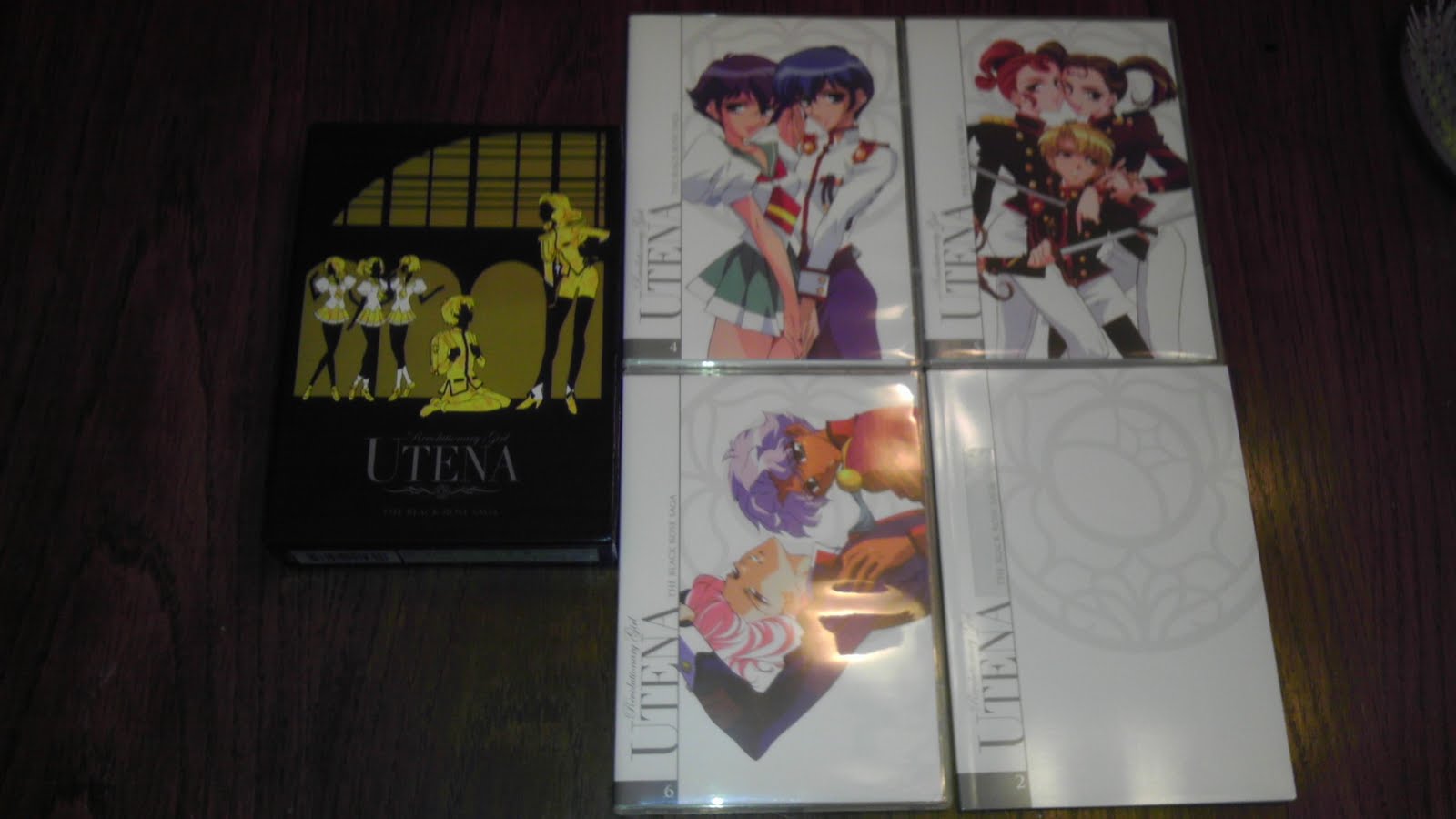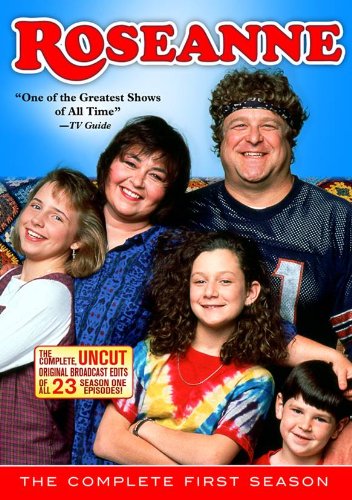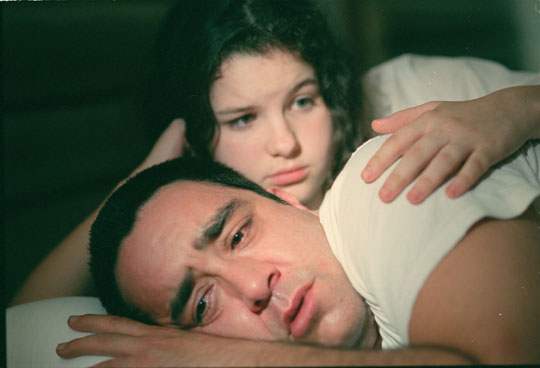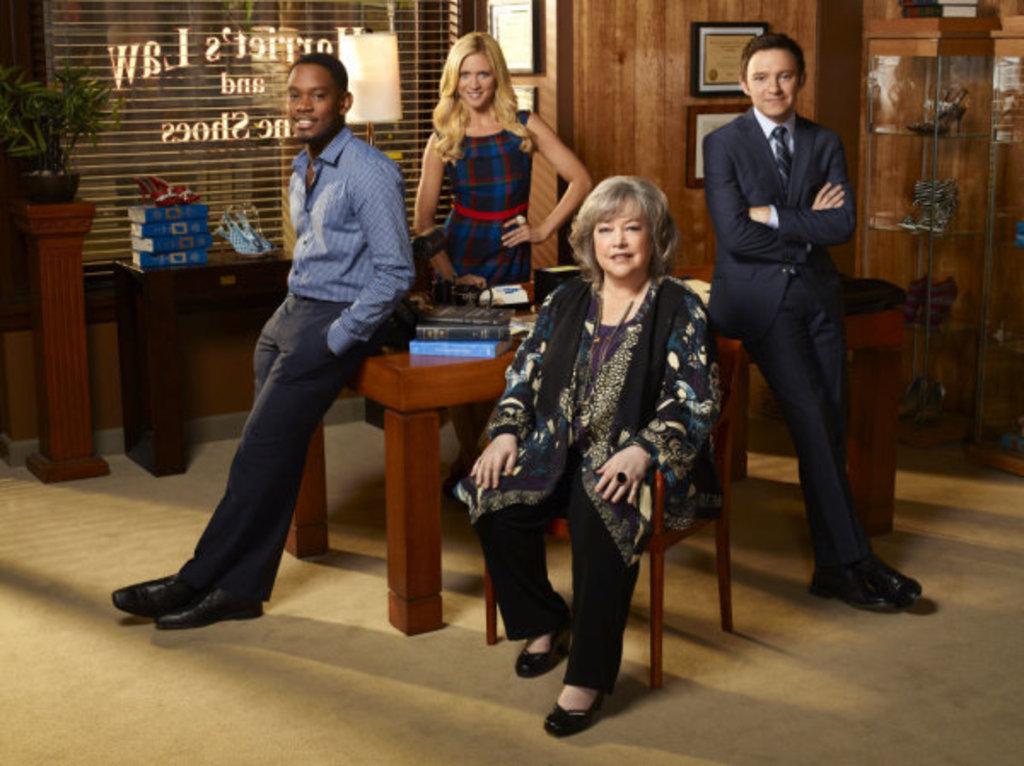-
Mark Valley Joins Harry’s Law
Entertainment Weekly has reported that Mark Valley will be joining the cast of Harry’s Law for its second season. It’s still unclear if he’ll be reprising his role of Brad Chase from Boston Legal or not. Personally, I hope he does and that all the Boston Legal regulars make at least a guest appearance at some point.
-
Review: Revolutionary Girl Utena-Black Rose Saga-Nozomi Release
Again, this is a review of the Nozomi release; not the series itself.
This set contains episodes 13-24, which include the last episode of The Student Council Saga and all of The Black Rose Saga (I don’t get it, either). This set comes in a nice art box, which contains three discs in slimcases, as well as a booklet.Extras:Disc One: Animated Storyboards-1997 Utena Japanese Promo-Nozomi TrailersDisc Two: Kunihuko Ikuhara Interviews 1 & 2, Nozomi TrailersDisc Three: Kunihuko Ikuhara Interviews 3 & 4, Nozomi TrailersBooklet:*Ikuhara’s episode commentary on the episodes included in this set*The Art of Shichiro Kobayashi, Art Director Interview*The Two Be-Papas: The Making of Be-Papas Studio, Part 1*Shinya Hasegawa, Character Designer Interview*Character Art Gallery*Rose and Blood: Utena’s Art Style*Key Art Gallery*Laserdisc Liner Notes from the Japanese Archives -
Review: Revolutionary Girl Utena-Student Council Saga-Nozomi Release
Note: This is a review of the Nozomi DVD release, not the series itself, which is fantastic.Around the ten year anniversary of the original airing of the ending of the Utena series it was announced that the series would be remastered and released on two DVD box sets, along with a CD box set. These were released in Japan in 2008. Now, Nozomi has started to bring this remastered set stateside in three box sets. This is my review of the first box set.Video: The video here looks amazing. Having seen this series on VCD, unofficial DVD, and official DVD, I can say without a doubt that this is the best Utena has ever looked. The remastering paid off. Colors that once looked muted and faded now look vibrant. -
Mill Creek Re-releases Roseanne & Others
Mill Creek Entertainment seems to have taken over several of the Carsey-Werner series that Anchor Bay used to put out. These series include Roseanne, Grounded For Life, That ’70s Show, and 3rd Rock From The Sun.
This is great news for Roseanne fans as this is the first time season one will be released uncut. With season one, the masters Carsey-Werner provided Anchor Bay were edited for syndication. This meant roughly three minutes of footage was chopped off every episode compared to the original broadcast versions. Fans were outraged and this was corrected on the remaining sets, but a complete set of season one was never released. Mill Creek will release seasons one and two of Roseanne on September 13. These are three-disc sets and they retail for $14.98.
You can pre-order here.
-
How Krzysztof Kieslowski’s Blue Follows the Hollywood Screenplay Template
Pages 1-11: Establish who and what the story is about, and suggest tone, place, and time. Subtly, or maybe not so subtly, give a clue to the basic issue to be dramatized in the story.Blue opens with its title card and swelling music. The next shot shows a tire, from behind, rolling on the pavement. We see three people driving in the car: Julie, Patrice, and Anna. Anna holds a sucker wrapper out the car window and watches it dance in the wind. The family stops so Anna can use the bathroom. As the car stops we see that the break line is leaking. Between the shot of the tire and the leaking break fluid, it is foreshadowed that this car ride is not going to end well.At the side of the road there is a young man, Antoine. He is concentrating on a game, trying to get a ball with a hole in it to go on the stick that is attached to it. After several unsuccessful attempts, he gets it, smiles, hears the crash and runs over. The car has hit a tree and is totaled. A deer runs from the scene and a beach ball rolls from the car.In the next scene we see the doctor reflected in Julie’s eye. He informs her that both her husband and child are dead. In the next scene, Julie, who is severely beaten up herself, breaks a window in the hospital hallway. As the nurse goes to check on the window, Julie goes behind the counter and stuffs her mouth with pills, in an attempt to end her life. She can’t do it and she spits the pills back into her hand and apologizes to the nurse.Olivier, Patrice’s partner, comes to the hospital and leaves Julie a television so she can watch her family’s funeral. It is revealed that Patrice was a world-famous composer who was working on the concert for the Unification of Europe. This is also the first glimpse we get of Julie’s mother at the funeral. Julie watches the funeral from her hospital bed.The first ten pages set up a lot. All but two of the key characters are introduced: Julie, Olivier, Antoine, and Julie’s mother. Though we do not know at the point that the old woman is Julie’s mother, we will realize it later in the film. Aside from characters, the basic plot is defined here, too. We are presented with a woman who has lost everything; she wants to die, but it is not in her to kill herself. What will she do? How can she live like that? How could anyone go on living after facing such loss? The whole film deals with the theme of liberty, but not in the way we would commonly think of liberty. It deals with liberty on a personal level. One is not liberated when they commit themselves to love or mourning and Julie is forced to come terms with this after the death of her family. Notice how Julie looks very sad, but she has not cried.
Tone and motifs are also set up within the first few pages. After the car crash we know that this movie will not be an easy or happy watch. This is a movie about life and death and it doesn’t take either lightly. The color blue is used extensively throughout the movie. In the first few pages we see blue in the sky, the car they are driving, and on the wrapper Anna hangs out the window. It is also established that music played a huge role to Julie’s family. This is important because music plays a big role in the film. We also gather that his film takes place in present day France. -
NBC Picks Up Harry’s Law for Another Season
It’s now on Wednesdays at 9. You can see their 2011-12 Primetime Schedule here.
-
Analyzing a Scene from Todd Solondz’ Palindromes
Todd Solondz’ Palindromes shows our world as a character gallery where each character has his or her own unique set of flaws and virtues. There are no heroes or villains here. Even if one chose to discern between the two, the heroes have flaws and the villains have virtues. People are who they are, for better or for worse, and there is no room for change.The film contends that people are palindromatic: we are the same, forwards and backwards: we always end up the way we started out. We cannot change. While some people may see this as depressing, the film, in its objectivity, does not. Of course, this way of thinking leaves no room for salvation, but on the other side of the coin, it also leaves no room for damnation. -
Harry’s Law
David E. Kelley’s new legal dramedy, Harry’s Law, premiered tonight on NBC. The main character is Harriet Korn, who after years of being a patent attorney, decides it’s boring. She gets fired from her job and then is promptly aerially assaulted by a suicidal man and then hit by a car. After a trip or two to the hospital she decides to open her own law firm in an abandoned shoe store.
It’s hard to judge the show on only the first episode. I liked most of what I saw. Keep in mind that most of Kelley’s series take at least a few episodes to really get going. He’s big on character, which isn’t something you can establish in one episode. I know a lot of people get sick of the “crazy law firm” formula, but the fact of the matter is: it works. Each of his legal shows have their own separate identity and tone. I dare anyone to watch all of Kelley’s television work then tell me he’s not the best thing to happen to television in the last two decades (some series excluded).
-
Thoughts on Kindle & Other “E-Media”
I had debated on getting a Kindle for a while. I love to read, though with school and work I often don’t have too much extra time to read for fun. For whatever reason, I never utilize the library and usually just buy books I’m interested in off of eBay or half.com. I had some reservations about the Kindle. Mainly, I like to be able to put my finger in a book and compare progress made to progress yet-to-make. There’s also the physical presence of a book. I’ll discuss that more in a bit.
At any rate, I asked for and received a Kindle for Christmas. I was about halfway done with my physical copy of The Heart Is A Lonely Hunter, but I said screw it and ordered the Kindle edition so I could check out my new Christmas present. It was weird reading on it for about six pages and then I didn’t even pay any attention to to the fact that I wasn’t reading a physical book. The e-ink screen actually looks like paper and after that very short awkward period I completely fell in love with my Kindle. I’m still figuring everything out, but I like everything about it thus far. -
On Maya Deren
 “I was a poet before I was a filmmaker. And I was a very poor poet because I thought in terms of images, what existed essentially as a visual experience in my mind. Poetry was an effort to put it into verbal terms. When I got a camera in my hand it was like coming home. It was doing what I always wanted to do without the need to translate it into a verbal form”–Maya DerenStan Brakhage once said that Maya Deren was “the mother of us all.” What he meant by this was that Maya was a significant influence to all experimental films and filmmakers that came after her. The purpose of this paper is to find out exactly what Brakhage meant; just how big of an impact did Deren have on the experimental film scene? The first part of this paper will be a biography and analysis of Deren and her work. The second part will compare and contrast Deren’s aesthetics to experimental films that came after her in hopes of finding out exactly what Brakhage meant.Maya Deren was actually born Elenora Derenkowsky.[1] She was born in Kiev, Ukraine, on April 24th, 1917. Her parents were both educated: her mother was a musician and her father was a psychiatrist. They moved to New York in 1922 due to the rise of anti-Semitism in Europe during this time. Her family took the last name “Deren,” which was the Americanization of Derenkowsky.Elenora had a hard time adjusting to a new language and culture, as would anyone at age five. When she grew up, she studied journalism and political science at Syracuse University. Deren become interested in filmmaking, dancing, poetry, and Socialism. After marrying Gregory Bardacke, she received her BA from New York University and went on to graduate from Smith College with a master’s degree in English. Upon graduation Deren began working as a secretary for Katherine Dunham, who was an anthropologist as well as a choreographer. Gregory and her were divorced in 1939. While working on a production for Dunham’s company Deren met a Czech filmmaker, Alexander Hammid. They married and according to Hammid, it was he who suggested that she changed her name to Maya; Maya was the name of the Mayan goddess of water. In 1943 Deren and Hammid began working on a film that would launch Maya’s filmmaking career.Meshes of the Afternoon beings with an arm dropping a single flower on the ground. A woman follows a hooded figure with a mirror-face. She drops a key, which later turns into a knife. She goes to her bedroom and watches herself follow the figure and enter the house. She interacts with several other versions of herself and she even tries to kill one. Reflections. Mirrors shatter. The ocean.
“I was a poet before I was a filmmaker. And I was a very poor poet because I thought in terms of images, what existed essentially as a visual experience in my mind. Poetry was an effort to put it into verbal terms. When I got a camera in my hand it was like coming home. It was doing what I always wanted to do without the need to translate it into a verbal form”–Maya DerenStan Brakhage once said that Maya Deren was “the mother of us all.” What he meant by this was that Maya was a significant influence to all experimental films and filmmakers that came after her. The purpose of this paper is to find out exactly what Brakhage meant; just how big of an impact did Deren have on the experimental film scene? The first part of this paper will be a biography and analysis of Deren and her work. The second part will compare and contrast Deren’s aesthetics to experimental films that came after her in hopes of finding out exactly what Brakhage meant.Maya Deren was actually born Elenora Derenkowsky.[1] She was born in Kiev, Ukraine, on April 24th, 1917. Her parents were both educated: her mother was a musician and her father was a psychiatrist. They moved to New York in 1922 due to the rise of anti-Semitism in Europe during this time. Her family took the last name “Deren,” which was the Americanization of Derenkowsky.Elenora had a hard time adjusting to a new language and culture, as would anyone at age five. When she grew up, she studied journalism and political science at Syracuse University. Deren become interested in filmmaking, dancing, poetry, and Socialism. After marrying Gregory Bardacke, she received her BA from New York University and went on to graduate from Smith College with a master’s degree in English. Upon graduation Deren began working as a secretary for Katherine Dunham, who was an anthropologist as well as a choreographer. Gregory and her were divorced in 1939. While working on a production for Dunham’s company Deren met a Czech filmmaker, Alexander Hammid. They married and according to Hammid, it was he who suggested that she changed her name to Maya; Maya was the name of the Mayan goddess of water. In 1943 Deren and Hammid began working on a film that would launch Maya’s filmmaking career.Meshes of the Afternoon beings with an arm dropping a single flower on the ground. A woman follows a hooded figure with a mirror-face. She drops a key, which later turns into a knife. She goes to her bedroom and watches herself follow the figure and enter the house. She interacts with several other versions of herself and she even tries to kill one. Reflections. Mirrors shatter. The ocean.







